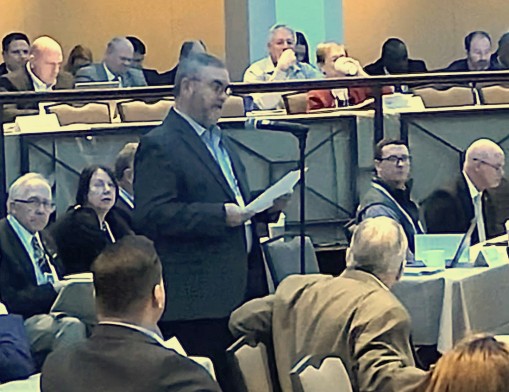NACo (National Association of Counties) Inland Waterways Infrastructure Investment Necessity Resolution Passed
National committee passes BOCC Chairman’s policy resolution
By: A Jesus Follower | Category: In Our Communities | Issue: March 2023

Rogers County Commissioner Chairman Ron Burrows of District 3 spoke before a national steering committee recently after submitting a policy resolution benefitting the nations inland waterways and ports.
The “NACo (National Association of Counties) Inland Waterways Infrastructure Investment Necessity Resolution” unanimously passed before NACo’s Transportation Policy Steering Committee during its 2023 Legislative Conference held February 11-14.
NACo’s resolution process allows members –– like Burrows –– the opportunity to participate in national policy decision affecting county governments.
Funding the Inland Waterway Navigation Infrastructure
Burrows, who sponsored the resolution, gave a presentation that will help policy makers urge Congress to immediately initiate a program dedicated to funding the Inland Waterway Navigation Infrastructure.
Of the resolution, Burrows said, “To get this resolution passed was very important since from the county’s perspective and recollection, there has not been a resolution to get funding for the inland waterways. This is a first for NACo to be able to have this sort of resolution push for funding involving inland waterways.”
According to the resolution, increased and accelerated investments into inland waterways is imperative for repairs and modernization improvements to the aging lock and dam infrastructure, and for the Nation’s continued dependence on this critical industry.
Top Priority Navigation Projects
Currently, there are 21 top priority navigation projects nationally that would cost an estimated $5.8 billion to complete.
If the completion of those 21 top priority navigation projects were accelerated to 10 years, then between 10,000 and 15,000 new jobs could create an annual economic value of $800 million.
In the second decade, completed navigation improvements could result in 10,000 new annual jobs throughout the economy, with a total income of $740 million in the first year.
If the inland water infrastructure fails, it would contribute to rapid, devastating economic impact costing trillions of dollars with other unforeseeable repercussions.
Burrows stated in the resolution that the inland waterway system is one of the least expensive, safest, and lowest carbon footprints of all transportation modes.
U.S. industries rely on inland waterway for economical shipment of grains, fertilizer, raw and finished steel, chemicals, minerals, building materials, and large equipment and machinery.
Additionally, more than 22% of domestic petroleum and petroleum products, and 20% of coal used in electricity generation is carried by our inland waterway system.
Anchoring the Nation's Economy
To give an idea of the monumental significance, a single barge can move 1,750 tons of goods. That is equal to 16 rail cars or 70 tractor trailers. Multiply those factors accordingly and the importance is greatly magnified.
In 2019 the inland waterways moved 514.9 million tons of waterborne cargo. That is a lot of cargo contributing to roughly 14 percent of all intercity freight valued at $134.1 billion, and responsible for over 500,000 nationwide jobs.
A healthy Inland Waterway Navigation Infrastructure anchors the nation’s economy. The fiscal, urban, and rural impact of the immediate investment will sustain 541,000 jobs, with more than $1 billion annually in new economic output.
Furthermore, infrastructure improvements over a 10-year period will lead to 350,000 new jobs with current economic value of $14 billion.
Ten policy steering committees and Board of Directors consider legislative and policy resolutions that guide NACo advocacy until the July 2023 NACo Annual meeting in Austin, Texas.
These policy resolutions serve as a guide for NACo members/staff to further advance the association's federal policy agenda before Congress, the White House, and federal agencies.
NOTE: NACo’s Transportation Committee is responsible for all matters pertaining to federal transportation legislation, funding and regulation, and its national impacts on county government. This includes highway/bridge development; finance and safety; public transit development and finance; transportation planning; airport development and service; passenger and freight railroads; ports and waterways; freight movement; and research and development of new modes of transportation.
Rogers County Commissioners
For more information, contact:
Rogers County Commissioners
More about Rogers County Commissioners:
More ArticlesSubscribe
For Free!



